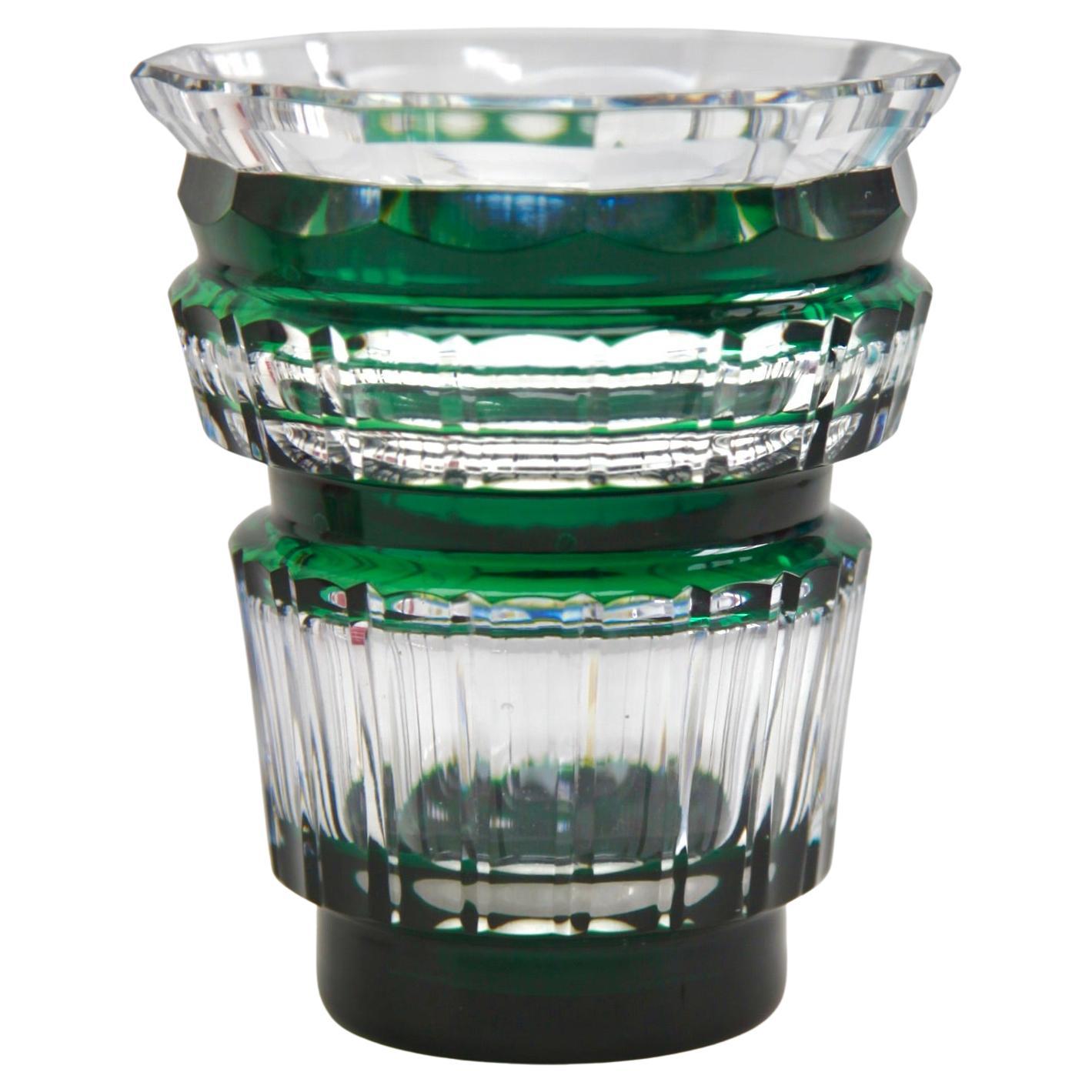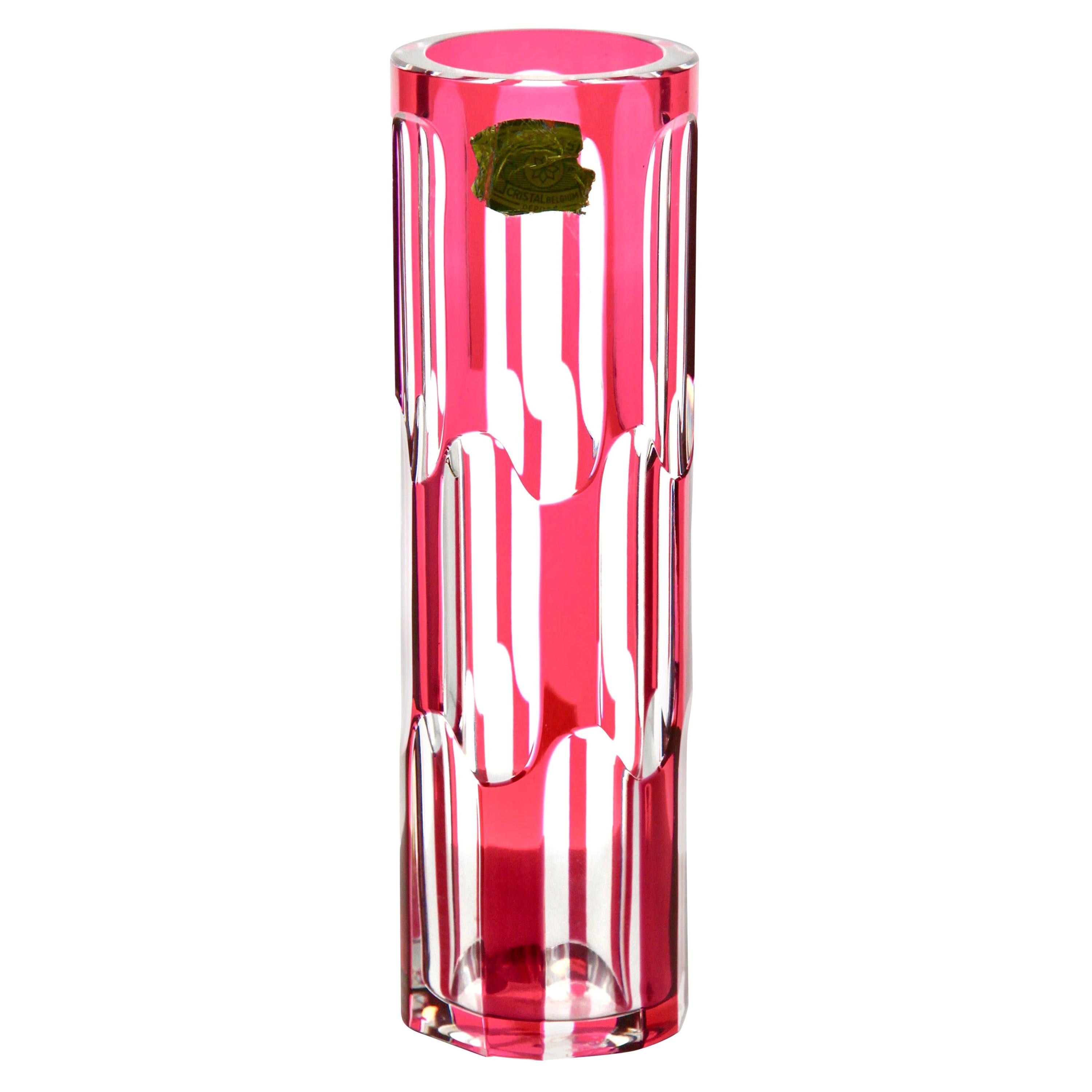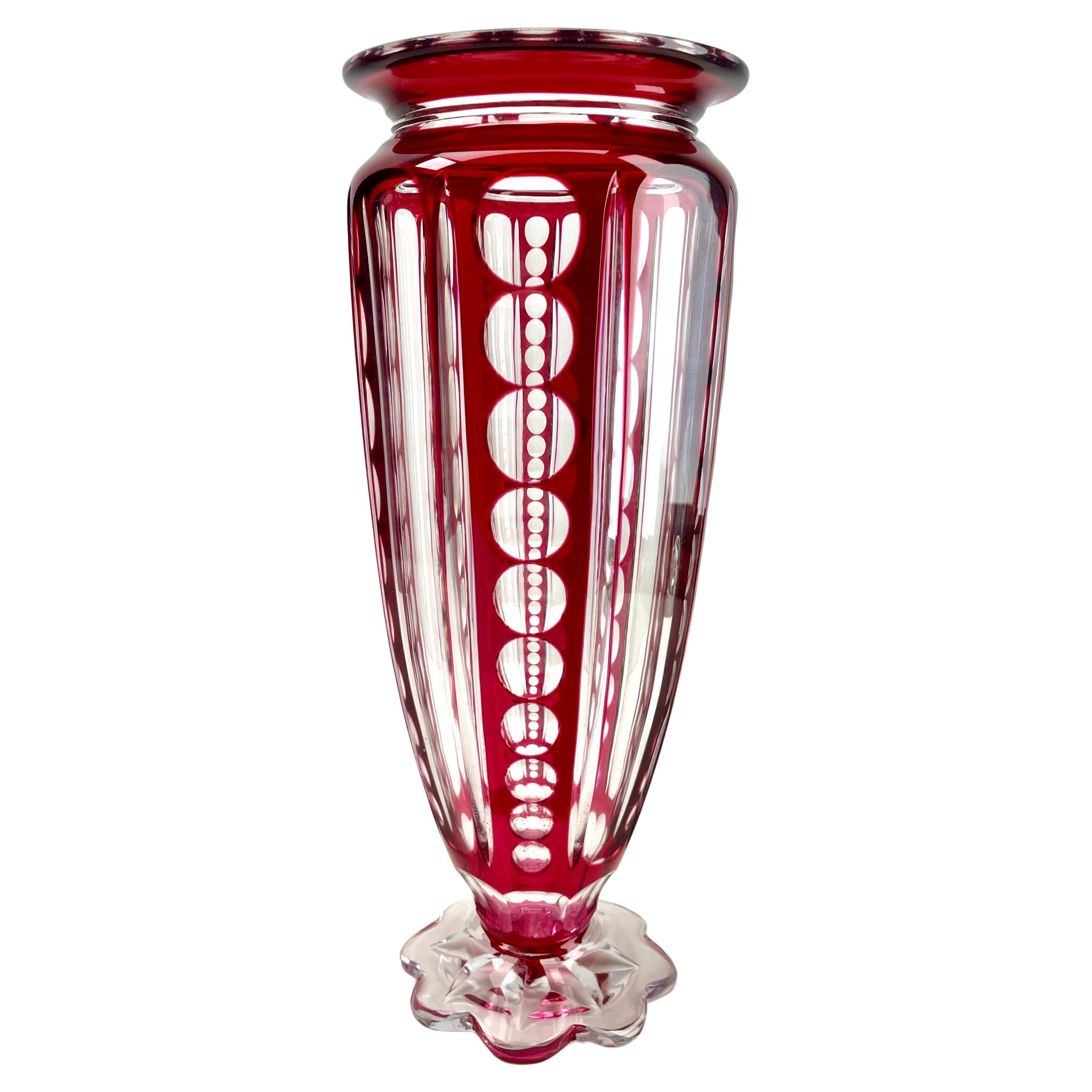Items Similar to Crystal Vase, 1930, Sign Val Saint Lambert
Video Loading
Want more images or videos?
Request additional images or videos from the seller
1 of 14
Crystal Vase, 1930, Sign Val Saint Lambert
About the Item
Vase of Crystal
We have specialized in the sale of Art Deco and Art Nouveau and Vintage styles since 1982. If you have any questions we are at your disposal.
Pushing the button that reads 'View All From Seller'. And you can see more objects to the style for sale.
Val Saint Lambert
Pre-history – Vonêche glassworks
In 1795 during the War of the First Coalition which brought about the fall of the Dutch Republic, France had annexed what was then termed the Southern Netherlands, now known as Belgium. During the period of the Napoleonic Wars, in 1802 Napoleon Bonaparte asked French industrialist Henri D'Artigues to leave the noted French crystal maker Saint-Louis to buy the dilapidated glassworks at Vonêche. Like Saint-Louis, Vonêche produced lead crystal glass, and within ten years had become the most important crystal producer in the French empire. Two of the key workers in the plant's success were chemist François Kemlin and engineer Auguste Lelièvre. In 1815 following Napoleon's defeat at the Battle of Waterloo, the Southern Netherlands was re-united within the new United Kingdom of the Netherlands. As a result of newly imposed import duties, the Vonêche factory immediately lost most of its French market. In 1816, D'Artigues negotiated with King Louis XVIII of France to buy the Verrerie de St Anne glassworks in the town of Baccarat, and renamed it the Verrerie de Vonêche à Baccarat – a name it kept until 1843. The Belgian Revolution of 1830 meant that the Vonêche glassworks also lost most of its Southern Holland market, and hence closed soon afterwards
In 1825 Kemlin and Lelièvre bought the site of the former Val-Saint-Lambert Abbey in Seraing near Liège on the river Meuse. There they founded a new glassworks (still in operation to this day, originally focused on heavy lead crystal), which initially employed some of the key workers from the former Vonêche glassworks. The two founders initially built two houses for themselves, and block accommodation for the acquired former Vonêche workers. Like similar highly religious employers, this policy of complete lifestyle development eventually led to the company building over 200 houses on the site to house workers, in what became a self-service village which also had a general store, school and post office; the local Roman Catholic church was also expanded to accommodate additional worshippers.
Due to the quality of its designs and manufacturing process, the company developed a well known brand and expanded. Aside from its home territory of Belgium and the Netherlands, the largest export market was to then Tsarist-ruled Russia. In 1876 the company opened a distribution base in New York, and in 1889 the company's CEO visited the store, and toured locally based competitor East Coast factories. As a result, on his return to Belgium the CEO noted in his report the then superior quality of American glass and the skill of its crystal cutters, which the company responded to by developing its own "bright" ranges and superior quality cutting.[2] The resulting "bright period" expanded the companies reputation and market especially in North America, and hence today it is well known and collected there for its Art Nouveau and Art Deco pieces. In 1894 at the world exhibition in Antwerp, the company manufactured an over 2 metres high vase consisting of 82 parts and weighing 200 kilograms, which is still intact and now on display at the Curtius Museum in Liège. As the company became more successful - at its height in the period 1900–1914, it employed over 5,000 workers creating 120,000 pieces of glass per day - the company contracted out work to other factories,[3] latterly either buying them or opening new factories, including: Jemeppe (1883 to 1952); two near Namur (1879 to 1935); and Jambes (1880 to 1931, producing oil glass lamps).[1]
The company stopped producing during World War I, and post-war after the Russian Revolution the market in Russia totally collapsed, resulting in financial difficulties and contraction. Exports to North America saved the company, but again it suffered difficulties with the collapse of that market post the Wall Street Crash of 1929. The company hence closed the Jambes and two Namur factories, and was stable by the time of World War II, during which like most of Belgium the factory was bombed by both the Nazi Luftwaffe and the Allied Air Forces of the RAF and USAAF. Production resumed initially in the less bomb-damaged Jemeppe factory until the production lines could be restored at Seraing, which resulted in the closure of the Jemeppe factory in the 1950s. Whilst many of the buildings at Seraing were restored, a large part of the site remained as was post-WW2 until the early 2000s, when these derelict 19th century buildings were cleared to create the modern steel-framed factory, visitor centre and small factory shop which exist today, together with the original restored 19th century factory offices.
Why are there so many antiques in Argentina?
In the 1880 – 1940 there was a grate wave of immigration encouraged by the periods of war that were taking place.
1st World War took place between 1914 and 1918
2nd World War took place between 1939 and 1945
The immigrants options were New York or Buenos Aires. Tickets were cheap and in Buenos Aires they were welcomed with open arms, as it was a country where everything was still to be done.
Argentina was the country of new opportunities, labour was needed and religious freedom was assured, in many cases the of the family travel first until they were settled and then the rest of the family members join them.
In the immigrant museum “Ellis Island Immigrant Building” in New York you can se the promotional posters of the boats that would take them to a new life.
Between the years 1895 and 1896, Argentina had the highest DGP (gross domestic product) per capita in the world according to the Maddison Historical Statistics index, this situation arose due to the large amount of food being exported to European countries, which were at war.
The Argentinean ships left the port of Buenos Aires with food, but they returned with furniture, clothes and construction elements, (it´s common to see this the old buildings of the historic neighbourhood of San Telmo, the beams with the inscription “Made in England)”, as well as many markets that were built in Buenos Aires, such us the San Telmo Market, whose structure was brought by ship and afterwards assembled in 900 Defensa Street.
With the great influence of European immigrants living in the country, the children of the upper classes travelled to study in France, resulting in the inauguration of “La Maison Argentinienne”, on 27th of June 1928, in the international city of Paris, which hosted many Argentinians that were studying in Frace.
It´s the fourth house to be built after France, Canada and Belgium, being the first Spanish-speaking one. Still in place today (17 Bd Jourdan, 75014, Paris, France). Many of the children of these wealthy families who attended international art exhibitions, museums and art courses abroad, took a keen interest in the European style. This is why Buenos Aires was at the time referred as “The Paris of South America”.
Between the years 1890 and 1920 more than a hundred Palaces were built on Alvear Avenue the most exclusive avenue in Buenos Aires. Today some of these palaces have been transformed into museums, hotels and embassies.
In the year 1936, the Kavanagh building was inaugurated, it was the tallest reinforced concrete building in South America.
During 1994 the American Society of Civil Engineers distinguished it as an “international engineering milestone”, and it´s now considered a World Heritage of Modern Architecture.
At the time was common to hire foreign architects such as Le Corbusier, who visited Buenos Aires/Argentina in 1929 and in 1948 he drew up the blueprints for a house built in La Plata City (which was declared a World Heritage Site).
In 1947, the Hungarian architect Marcelo Breuer designed “Parador Ariston” in the seaside city of Mar del Plata. After an Argentinean student at Harvard University convinced him to come to Argentina. He worked on an urban development project in the Casa Amarilla, area of La Boca.
The Ukrainian architect, Vladimiro Acosta, arrives in Argentina in 1928 and worked as an architect until que moved to Brazil.
Antonio Bonet, a Spanish architect who worked with Le Corbusier in Paris, arrives in Argentina in 1937, where he carried out several architectural works and in 1938 designs the well-known BFK chair.
Andres Kálnay, of Hungarian origin, made around 120 architectural masterpieces, among which the former Munich brewery stands out, he even made the furniture’s design.
The German architect, Walter Gropius, director of the Bauhaus, lived in Argentina, where he wrote articles for “Sur” magazine and founded in Buenos Aires, an architectural firm with Franz Möller, who was also an architect, where he built two houses.
At the same time several famous designers decided to immigrate to Argentina, among them we can find the well-known French designer, Jean-Michel Frank, who arrived in the country in 1940 and also worked for the Rockefeller family.
Special pieces were made, which were sold exclusively in the country, such as the well-known German company “WMF”, who sold their products by catalogue, which were chosen by the ladies of high society in the list of wedding gifts, as well as the pieces designed by Christofle.
The Swiss sculptor Alberto Giacometti, made special pieces for Argentinean mansions.
In 1904 the first Jansen branch outside Paris was established in Buenos Aires, as the Argentinean clientele demanded a large amount of furniture, from the end of the 19th century to the mid-20th century.
In 1970, the brand Rigolleau Argentina made pieces authorised by Lalique.
The brands Maple and Thompson also set up shop in the country.
The French plastic artist, Marcel Duchamp moved to Argentina in 1918-1919.
Glass signed Gallé, Charder, Leverre, Schneider, Muller and other French firms. They were bought in flower shops and were given to ladies with beautiful floral arrangements.
Some furniture manufacturers travelled to international fairs and bough the patterns to produce the furniture in Argentina, such as the furniture firm Englander and Bonta, who bought the patterns ins Italy.
It is worth mentioning that in Argentina we have the largest community of Italians outside of Italy, as it is estimated that 70 percent of the inhabitants have at least one Italian descendant, followed by Spanish immigrants.
The most Important furniture stores in Argentina:
Comte is founded in 1934 (under the direct management of Jean Michel Frank in 1940).
Nordiska (Swedish company established in 1934).
Churba in 1960, a company that brought foreign designers to present their furniture in the country:
Denmark: (Arne Jacobsen, Finn Juhl, Bender Madsen, Ejner Larsen, Poul Kjaerholm, Hans Wegner)
Sweden: (Hans Agne Jakobsson, Gustavsberg)
United States: (Herman Miller)
Finland: (Lisa Johansson, Folke Arstrom, Tapio Wirkkala, Alvar Aalto, Timo Sarpaneva)
Swedish Factory: (Orrefors)
Italy: (Littala, Vico Magistretti, Emma Gismondi, Gae Aulenti, Angelo Mangiarotti, Elio Martinelli, Gianna Celada, Angelo Mangiarotti, Mario Bellini, Carlo Scarpa)
Finland: (Olivia Toikka)
Plata Lappas (Lappas Silver): a goldsmith shop founded in 1887 in Argentina by Alcibiades Lappas of Greek origin.
In 2019, in Argentina took place “the Art Deco world congress”, in which we participated as hosts invited by Geo Darder, founder of the Copperbridge – Foundation, in which prominent people from all over the world attended to learn about Art Deco in Argentina.
Argentina currently has more than 100 Art Deco buildings and another 90 Art Nouveau buildings throughout the city of Buenos Aires.
Argentina is a country that has not been involved in many wars, which is why it has been a refuge for works of art and antiques from different periods of time, unlike European countries. That is way many collectors, museums and antique dealers from all over the world visit it, you should not miss the opportunity to visit this great country.
Laura Guevara Kjuder, architect.
- Creator:Val Saint Lambert (Designer)
- Dimensions:Height: 1.58 in (4 cm)Diameter: 7.09 in (18 cm)
- Style:Art Deco (Of the Period)
- Materials and Techniques:
- Place of Origin:
- Period:
- Date of Manufacture:1930
- Condition:Wear consistent with age and use.
- Seller Location:Ciudad Autónoma Buenos Aires, AR
- Reference Number:
About the Seller
5.0
Vetted Seller
These experienced sellers undergo a comprehensive evaluation by our team of in-house experts.
Established in 1982
1stDibs seller since 2022
21 sales on 1stDibs
Typical response time: <1 hour
- ShippingRetrieving quote...Ships From: Ciudad Autónoma Buenos Aires, Argentina
- Return PolicyThis item cannot be returned.
More From This SellerView All
- Crystal Vase, 1930, Attributed to Val Saint LambertBy Val Saint LambertLocated in Ciudad Autónoma Buenos Aires, CVase of crystal We have specialized in the sale of Art Deco and Art Nouveau and Vintage styles since 1982. If you have any questions we are at your disposal. Pushing the button that ...Category
Vintage 1930s Belgian Art Deco Crystal Serveware
MaterialsCrystal
- Crystal vase , 1930Located in Ciudad Autónoma Buenos Aires, CVase of Crystal We have specialized in the sale of Art Deco and Art Nouveau and Vintage styles since 1982. If you have any questions we are at your disposal. Pushing the button that...Category
Vintage 1930s Swedish Art Deco Crystal Serveware
MaterialsCrystal
- Crystal Pair of Candles, 1930, Sign, Rogaska 'Slovenia'By Rogaska CrystalLocated in Ciudad Autónoma Buenos Aires, CCrystal Pair of candles We have specialized in the sale of Art Deco and Art Nouveau and Vintage styles since 1982. If you have any questions we are at yo...Category
Vintage 1930s Slovenian Art Deco Crystal Serveware
MaterialsCrystal
- Vase in Murano, Italian, 1920Located in Ciudad Autónoma Buenos Aires, CVase in Murano We have specialized in the sale of Art Deco and Art Nouveau and Vintage styles since 1982. If you have any questions we are at your disposal. Pushing the button that ...Category
Vintage 1920s Italian Art Deco Crystal Serveware
MaterialsMurano Glass
- Vase in Crystal 1985, Sign: Crystal Querandi Yugendstil 0294/85Located in Ciudad Autónoma Buenos Aires, CSign: Crystal Querandi Yugendstil 0294/85 We have specialized in the sale of Art Deco and Art Nouveau and Vintage styles since 1982. If you have any questions we are at your disposa...Category
Vintage 1940s Argentine Art Deco Abstract Sculptures
MaterialsCrystal
- France Crystal 1930Located in Ciudad Autónoma Buenos Aires, CCrystal We have specialized in the sale of Art Deco and Art Nouveau and Vintage styles since 1982. If you have any questions we are at your disposal. Pushing the button that reads '...Category
Vintage 1930s French Art Deco Centerpieces
MaterialsCrystal
You May Also Like
- Val Saint Lambert Crystal Vase Cut to Clear, SignedBy Val Saint LambertLocated in Verviers, BEVal Saint Lambert crystal vase cut to clear, label and signed Beautiful Val Saint Lambert circular crystal vase, hand-cut-to-clear, th...Category
Vintage 1950s Belgian Art Deco Crystal Serveware
MaterialsCrystal
- Val Saint Lambert Crystal Vase Cut to Clear, SignedBy Val Saint LambertLocated in Verviers, BEVal Saint Lambert crystal vase cut to clear, and signed Beautiful Val Saint Lambert circular crystal vase, hand-cut-to-clear, the glas...Category
Vintage 1950s Belgian Art Deco Crystal Serveware
MaterialsCrystal
- Val Saint Lambert Crystal Vase Charles Graffart Cut-to-Clear SignedBy Val Saint LambertLocated in Verviers, BEVal Saint Lambert vase Charles Graffart, catalogue, 1950s. Beautiful signed Val Saint Lambert circular crystal vase, handcut-to-clear, the glass is thick, deeply and evenly cut, ...Category
Vintage 1950s Belgian Art Deco Crystal Serveware
MaterialsCrystal
- Val Saint Lambert Crystal Vase Charles Graffart Cut to Clear SignedBy Val Saint LambertLocated in Verviers, BEVal Saint Lambert vase Charles Graffart, catalogue, 1950s. Beautiful signed Val Saint Lambert circular crystal vase, handcut-to-clear, the glass is thick, deeply and evenly cut, Sig...Category
Vintage 1950s Belgian Art Deco Crystal Serveware
MaterialsCrystal
- Val Saint Lambert Crystal Vase Cut to ClearBy Val Saint LambertLocated in Verviers, BEVal Saint Lambert crystal vase cut to clear Beautiful Val Saint Lambert circular crystal vase, hand-cut-to-clear, the glass is thick, deeply and evenly ...Category
Vintage 1950s Belgian Art Deco Crystal Serveware
MaterialsCrystal
- Art Deco Val Saint Lambert Crystal Vase Cut to Clear, SignedBy Val Saint LambertLocated in Verviers, BEVal Saint Lambert crystal vase cut to clear, signed Beautiful Val Saint Lambert circular crystal vase, hand-cut-to-clear, the glass is thick, deeply and evenly cut, Origin: Belg...Category
Vintage 1930s Belgian Art Deco Crystal Serveware
MaterialsCrystal
Recently Viewed
View AllMore Ways To Browse
1930 Kitchen
Vintage Key Sign
Saint Vintage Designs
Collectors Crystals
Crystal Button
Crystal Gifts
Vintage French Shop Signs
Vintage French Kitchen Signs
Hungary 1930
Vintage Kitchen Range
Vintage Kitchen Ranges
Vintage French Market Signs
Used Island For Kitchen
Ladies Vintage Glasses
Antique Ladies Sign
Jansen Signed
French Art Glass Saint
Key Crystal





